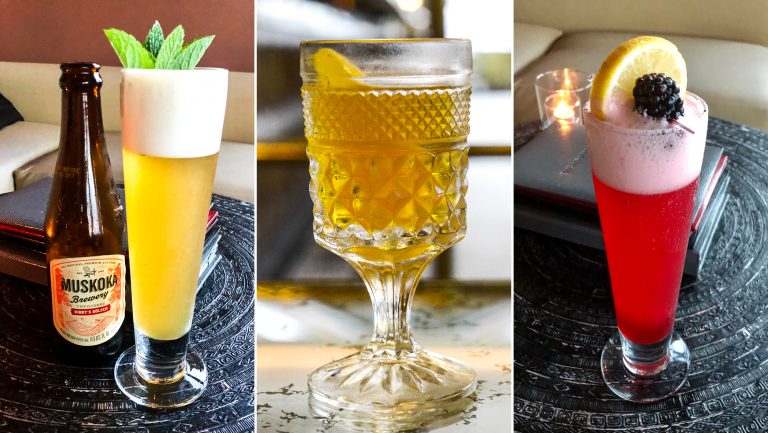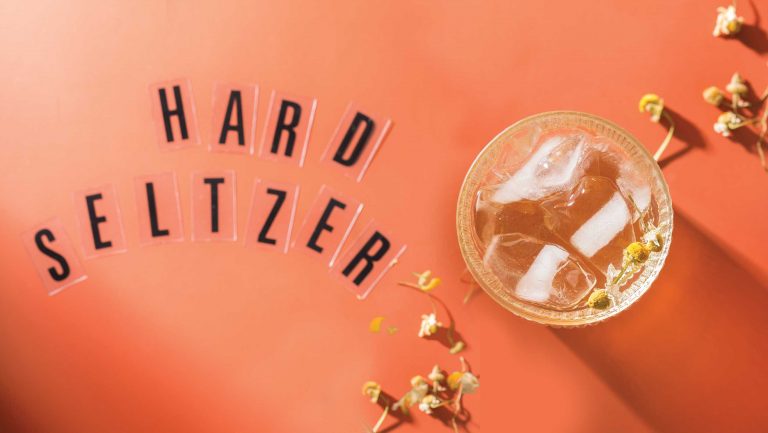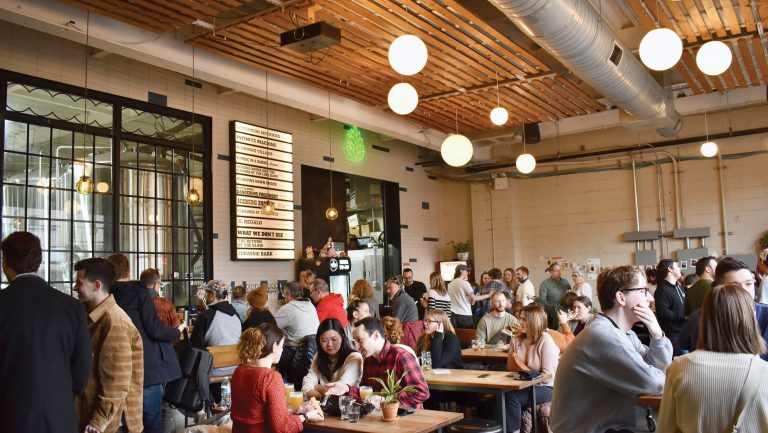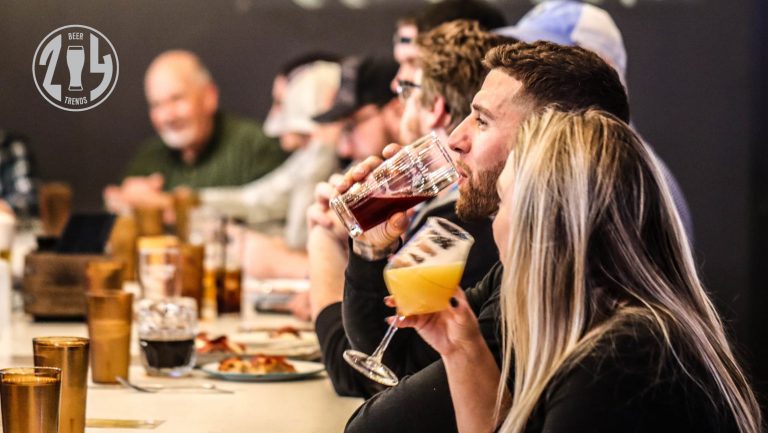Adding something flavorful to a glass of beer is nothing new. The lager and lemonade combo of Europe, known by various names—shandy, panaché, and radler—has been around for nearly a hundred years. Mexican cheladas and micheladas are variations on the same theme, made with fresh lime juice instead of lemons and often served with a hit of salt and hot sauce. In Eastern Europe, herbal syrups have long been used to counteract the sourness of Berliner weisse—this may have been the original beer cocktail, suggests Matt Russell, beverage lead and beer programmer of Easy Tiger in Austin, Texas.
What is relatively new is mixing a spirit into a draft of beer with the intention of creating a properly balanced cocktail. This more refined style of beer cocktail is emerging as a new category in the industry, and some bartenders believe the drinks are pushing boundaries and helping the craft cocktail movement evolve. Russell Lewis, the owner of Watermark in Asbury Park, New Jersey, is enthusiastic about the new cocktails, saying, “They’re so sophisticated and cool and complex.” For a long time, Watermark had just one beer cocktail on its menu, the chelada, but it proved to be so popular that Lewis began adding more beer cocktails—and upping the ante on their flavor profiles. Now the menu offers half a dozen, and Lewis has more in development.
Frank McGrath, the general manager of Polite Provisions in San Diego, believes that with its wide range of styles and flavors, beer is quickly becoming another modifier in cocktails. He also says that consumers are eager to try the new concept. “We have to do things [in the drinks industry],” he says, “that are constantly unique and different to make sure everyone is stimulated.”

Don’t miss the latest drinks industry news and insights. Sign up for our award-winning newsletters and get insider intel, resources, and trends delivered to your inbox every week.
There are also practical reasons to include beer cocktails on a drinks menu, says Laura Dierks, the founder and CEO of Interboro Spirits and Ales in Brooklyn, who crafts beer cocktails to showcase both her company’s distilled and brewed products in a single drink. Additionally, she points out that if a restaurant is limited by a beer and wine license, jazzing up a beer with nonalcoholic ingredients is an innovative way to offer something called a cocktail—it also keeps a cocktail’s ABV lower.
Something that unites bartenders who mix beer cocktails, though, is the desire to draw attention to the dynamic craft beers being produced by their local breweries. “These beers are super well made and very precise in terms of flavors,” explains McGrath, “[which] makes it easy for us to incorporate [them] into cocktails.”
Crafting Beer Cocktails
The beer itself is typically the starting point in designing a beer cocktail, and the goal is to highlight and preserve its unique character. So it’s important to choose spirits that offer complementary flavors and won’t overpower the beer. Gin is a go-to spirit for Easy Tiger’s Russell; Dierks likes to mix beer cocktails with Interboro’s unaged apple brandy.
Dierks advises using high-quality ingredients and striving for a balance of flavors, as with any cocktail. Darker spirits, for example, typically pair well with darker beers. Russell adds that because the beer already has a lot flavor, it’s best to stick with just two or three additional ingredients. “Otherwise, you’re going to wash out the flavors that already make that beer great,” he says. “I’ll pick a citrus and a liqueur to complement the beer.”
Citrus is a natural pairing, as shown by the enduring success of early beer concoctions like the shandy and the michelada. Grapefruit is a particularly good option, whether as juice, liqueur, peel, or bitters. Many craft beers already have this zesty note, and the addition of grapefruit enhances their flavor, says Dierks. McGrath finds that grapefruit plays off the skunky, bitter, hoppy notes in beer. “For some reason,” he says, “it works really nicely and brightens up that bitter element.”
Straight-up classic cocktails, such as the French 75, gin fizz, and Manhattan, can easily be beer-ified by substituting beer for the base ingredient (or a secondary one) or using it to play up the others. In a French 75, for instance, a citrusy sour beer can take the place of Champagne and boost the lemon flavor. The bitter elements of a double IPA can assume the role of Angostura in a Manhattan, says Greg Schaefer, a bartender at Watermark, who is adding a new Double IPA Manhattan to the bar’s menu.
In preparing beer cocktails, preserving the carbonation is key, as the effervescence is vital for the mouthfeel. The best way to do this is to add the beer after shaking or stirring the other ingredients, and then either topping the drink, already in a glass, with the beer or pouring the beer directly into the cocktail shaker and giving it a gentle stir before straining the contents into a glass. For richer beer cocktails that are based on flips, the beer should be degassed by stirring it in the cocktail shaker and then shaken with the other ingredients. This method adds to the weighty mouthfeel of the cocktail. Finally, whatever beer you choose, make sure it’s really fresh, says Dierks, because age can cause hops to lose their desirable fruit notes and become more bitter.
Most beer cocktails are served in a standard beer glass, often with the opened bottle of beer on the side if draft beer hasn’t been used. But at Watermark, the bartenders have seen the category giving way to more drinks like Old Fashioneds and Manhattans, with beer as a sophisticated, balancing ingredient, so they’ve transitioned to serving many of their beer cocktails in rocks glasses with a large ice cube to encourage sipping.

But do beer cocktails sell? They do—perhaps not at the top of the pack, says Russell, but certainly not at the bottom. What’s attractive about the beer cocktail for a bar is that it has the potential to appeal to a wide range of customers, offering a little something for everyone––an intro to craft beer for cocktail drinkers, and an invitation to the cocktail world for hop enthusiasts.
“It appeals to both,” says Russell, “and most drinkers are open to trying new things.” He’s observed that “a lot of younger cocktail drinkers that are now getting into craft beers find it’s a good balance between the two” and adds that if somebody likes the style of beer that he’s used in a particular beer cocktail, they’re more likely to try the classic version of the cocktail another time. At Easy Tiger, he says it’s common for customers to start out with a traditional cocktail or two, and then end up in “the beer cocktail zone.”

Dispatch
Sign up for our award-winning newsletter
Don’t miss the latest drinks industry news and insights—delivered to your inbox every week.
Diana Pittet owns Night Owl Hospitality, a cocktail catering company in Asbury Park, New Jersey, and is an adjunct professor at New York University, where she teaches a graduate class on the history, culture, and politics of drinking.







